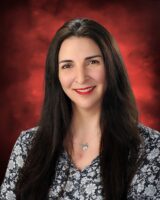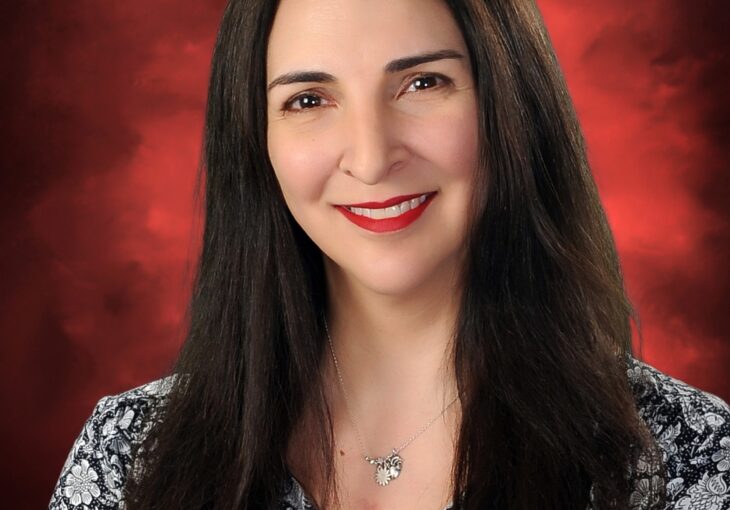
Stephanie Mazloom Hammonds, BSN, RN
As a child, Stephanie Mazloom Hammonds, BSN, RN, would feel faint when it was hot, and sometimes actually did faint. She was also the only member of her family who was tall, almost 5’9” by age 13, and she was very thin for her height.
When she was 3, a heart murmur led to a chest X-ray that showed her heart was possibly enlarged. Hammonds’ parents took her to a pediatric cardiologist in Albany for an echocardiogram, a procedure that was repeated every 3 years. This showed a mitral valve prolapse, but no heart enlargement, and no reason for the fainting. However, doctors also noted that her aorta should be watched for a “possible connective tissue” problem in the future.
When Stephanie was 14 years old, an article about the sudden death of professional volleyball player and Olympic silver medalist Flo Hyman, in 1986, sparked something for Hammonds’ mother, Gina Mazloom.
“Flo Hyman died of a ruptured aorta aneurysm, a ballooning like bulge of the major artery that carries blood directly from the heart to the rest of the body. This was caused by undiagnosed Marfan syndrome, a connective tissue disorder,” Hammonds said. Descriptions of Hyman’s physical appearance were too similar for Gina to ignore. “I had had scoliosis since I was 7, and I was so tall and thin, even as a toddler. I had some unusual, though seemingly benign heart issues; my mother put 2 and 2 together, and said, ‘that’s sounds just like my daughter.’”
Gina moved quickly to care for her daughter, and a consultation with a geneticist provided Stephanie with her official diagnosis of Marfan Syndrome, and some relief.
“I had gone through a lot of self-doubt and low self-esteem with all these signs and symptoms that seemingly didn’t fit together, but are associated with Marfan’s,” Hammonds said. “I was very tall, had a very wide arm span, a weird heart condition, joint issues, scoliosis, a high upper palate, near-sightedness, and unexplained stretch marks. We were pretty amazed to find out not only was everything related, but it had a name.”
That was just the start of Hammonds’ journey. As she moved into her 20s, doctors increased the monitoring of the size of her aorta to yearly tests, concentrating especially on the aortic root and started to call it an aortic root aneurysm.
She had corrective surgery for scoliosis at the age of 26 – which required steel rods, screws in 10 vertebrae, and a nine-month recovery period. Stephanie and her family thought that would be the worst of the Marfan ordeal.
“We were so sure that I just wouldn’t need heart surgery too; not after dealing with my spine. It just seemed too ridiculous,” Hammonds said.
But at age 31, her routine annual echocardiogram showed a jump in the growth of the aortic root aneurysm, and a CT scan confirmed rapid enlargement from 4 centimeters to 5 centimeters in one year.
“For a Marfan’s patient, 5 centimeters is an emergency,” Hammonds said.
At the time, Hammonds was home on a semester break from attending medical school in Antigua, along with her then-boyfriend/now-husband, Jake.
“I took a leave of absence from med school and became a patient all over again. It was devastating. I was so scared. I’m grateful everyday that I had the support from Jake, my incredible mom and my family and friends,” Hammonds said. “It took a couple of months to coordinate consults, find the right surgeon and facility, and insurance. But I ended up having a relatively new and lifesaving procedure at the Cleveland Clinic, called the David Procedure: valve sparing aortic root replacement. It not only saved my life, it saved my healthy aortic valve in my heart.”
Yet another discovery came during that surgery: Hammonds had a hole in her heart they’d never known about. Doctors were able to quickly repair the hole, a patent foramen ovale (PFO) that all babies are born with, but that, with most people, usually closes on its own. The mystery of the fainting from heat intolerance was finally explained.
Hammonds and her mother spent two weeks in Cleveland for pretesting, surgery and recovery. They were joined by Jake, her father Paul, and her sister Camley. Eight weeks after her surgery, Hammonds was back on a plane to med school in Antigua.
After two more semesters as a medical student, Hammonds realized she wanted a life with more flexibility, and became a registered nurse.
Today, she also monitors an unusual condition that’s a result of the development of her heart when she was a fetus.
“I have a myocardial bridge, where one or more of the coronary arteries that usually lay on top of the heart muscle tunnel under the muscle instead,” Hammonds said. “As a result, when my heart pumps, my left anterior descending artery gets squeezed. Although, I can get some angina, I’ve been deemed non-surgical. There’s also some concern that I might need another surgery in the future if I develop another aneurysm.”
Hammonds takes a beta blocker to keep her heart rate low to allow enough oxygen to flow to her heart; and a medication to keep her blood pressure low to help decrease the development of another aneurysm. Hammonds also shared that she had an arrhythmia called supraventricular tachycardia (SVT), and had a cardiac ablation procedure for that, at the Johns Hopkins Hospital, in 2017.
“For 40 years, nobody told me this disruptive, randomly occurring rapid heart rate was treatable,” Hammonds said. “Since the ablation, I haven’t had an unexplained rapid heart-rate symptom in seven years.”
This probably also contributed to the heat intolerance and fainting spells. Another mystery solved.
Hammonds is sharing her story at the Mohawk Valley Go Red for Women Luncheon on May 2 to raise awareness about her conditions.
“A lot of people don’t understand that heart disease isn’t just clogged arteries and triple bypass,” she said. “I know that firsthand.”
Hammonds looks at the positive that has come out of her life, even when she was scared.
“What else are you going to do?” she asked. “You find out these things and get through them. I’m alive because of awareness, and because we knew what I had. I’m alive because of my mom. My story shows that you can move on from congenital heart defects, from heart surgery and even heart damage. I choose joy every day; I realize how lucky I am; what a great support system I have with my mother, my husband, family, and friends; and how none of this has held me back, professionally or intellectually. I want to continue to raise awareness about heart disease, especially if it’s not what we commonly think of as heart disease.”
Stephanie is a registered nurse at Community Memorial Hospital in Hamilton, NY. She lives in Clinton, NY with her husband Dr. Isaiah “Jake” Hammonds, and is the proud step-mother to his son, Zaiah, and two daughters, Maya and Hanna.
The Mohawk Valley Go Red for women Luncheon is set for Thursday, May 2, from 10:30 a.m. – 1 p.m. at the Delta Hotels by Marriott Utica at 200 Genesee St., Utica. For information or to register, visit heart.org/mvgoesred.
